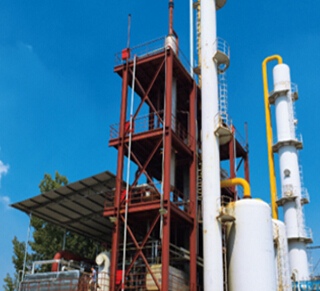|
|
|
其工艺技术有如下特点。 The process technology has the following characteristics.
1、选择高质量脱硫催化剂至关重要:在湿式氧化法脱硫中,将H2S氧化成单质硫是借助于脱硫液中的载氧体催化剂来实现的。催化剂在很大程度上决定着湿式氧化法的脱硫效率,单质硫生产率、碱耗、再生效率,副反应产率等一系列重要指标。因此,选择一种高性能催化剂作为氧化还原剂,就成为决定这种工艺操作的关键。
1. It is very important to select high-quality desulfurization catalyst: in wet oxidation desulfurization, the oxidation of H2S to elemental sulfur is realized by means of oxygen carrier catalyst in desulfurization liquid. The catalyst largely determines the desulfurization efficiency of wet oxidation method, a series of important indexes such as elemental sulfur productivity, alkali consumption, regeneration efficiency and side reaction yield. Therefore, choosing a high-performance catalyst as redox agent has become the key to this process operation.

2、不管采用何种催化剂,其化学反应过程的共同特点是要分三步走:一步用氨水或纯碱液吸收气体中的H2S进行中和反应。二步采用载氧体催化剂进行催化氧化反应把HS-、S-2氧化成单质硫。第三步加入或喷射自吸空气氧化失活的催化剂,使其得到再生,循环使用。同时将单质硫浮选出来分离出去,熔炼硫磺。而且从工艺上看,一步吸收反应肯定在脱硫塔中进行。气液两相逆流接触,通过传质(填料)H2S从气相介面向液相介面转移,进入液相主体。酸碱中和反应,生成相应的盐转化为富液。此过程中受气膜控制属扩散式吸收。然而催化、氧化、析硫的二步化学反应,也主要在脱硫塔内进行。因而,也形成了这种复杂相系共存格局。故此,传质面积、喷淋密度、液气比、碱度、PH值、催化剂浓度、反应温度等都会影响吸收的选择性及析硫再生和气体净化度。
2. No matter what kind of catalyst is used, the common feature of its chemical reaction process is that it should be divided into three steps: one step is to absorb H2S in the gas with ammonia or soda solution for neutralization reaction. In the second step, the oxygen carrier catalyst is used for catalytic oxidation reaction to oxidize HS - and S-2 into elemental sulfur. The third step is to add or spray the self-priming air oxidation deactivated catalyst to regenerate and recycle it. At the same time, the elemental sulfur is separated by flotation and melted. Moreover, from the process point of view, the one-step absorption reaction must be carried out in the desulfurization tower. The gas-liquid two-phase countercurrent contact transfers H2S from the gas phase interface to the liquid phase interface through mass transfer (packing) and enters the main body of the liquid phase. The acid-base neutralization reaction generates the corresponding salt and converts it into rich liquid. This process is controlled by the gas film and belongs to diffusion absorption. However, the two-step chemical reactions of catalysis, oxidation and sulfur evolution are also mainly carried out in the desulfurization tower. Therefore, the coexistence pattern of this complex phase system is also formed. Therefore, mass transfer area, spray density, liquid gas ratio, alkalinity, pH value, catalyst concentration and reaction temperature will affect the selectivity of absorption, sulfur evolution regeneration and gas purification.
|
|
